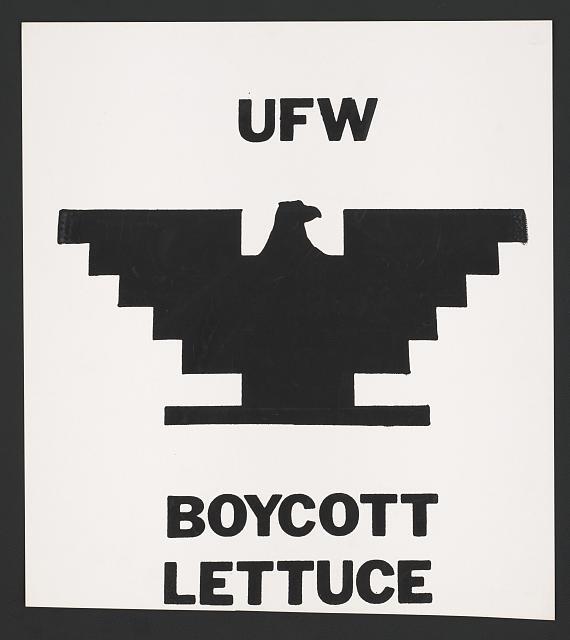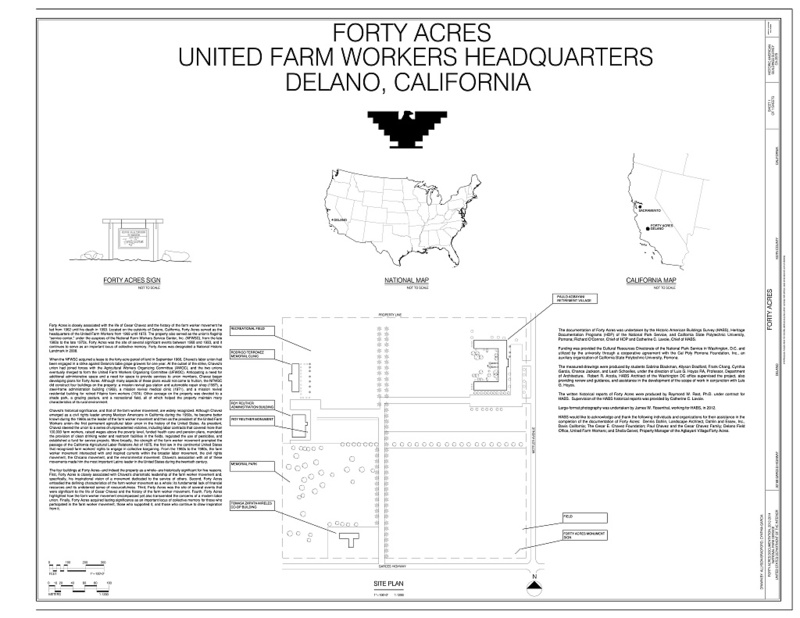The United Farm Workers
In 1962, Cesar Chavez and his colleagues from the CSO, Dolores Huerta, and Gilbert Padilla, founded the United Farm Workers association to organize farm workers, hispanic and non-hispanic, across the American Southwest. The UFW’s main concerns included securing higher wages for migrant workers, better working conditions in the fields, and eliminating the use of deadly pesticides. Cesar Chavez spearheaded the negotiations with big farmers and drew on examples from other Civil Rights leaders, such as Martin Luther King Jr. and Mahatma Gandhi, to achieve the union’s goals. One of his most widely known methods of protest was the hunger strike, which Gandhi also practiced, in order to pressure farmers to negotiate.
The image above features the symbol of the United Farm Workers labor union founded in 1962. The eagle was designed by Richard Chavez, brother of the UFW’s founder Cesar Chavez, and drew on the iconographic style of the Aztecs. Using the Aztec eagle was a way to connect the UFW to the Mexican heritage of its members and further legitimize the movement. Richard Chavez also designed the symbol in a simple style that would be easy to reproduce on posters, signs, and other materials used during protests and boycotts. The eagle was also featured on legal documents, such as contract negotiations, and became an important emblem of the UFW’s successes.
The United Farm Workers association was largely successful in securing rights and benefits for migrant workers. In the 1960s, the UFW opened up schools throughout California, most notably in La Paz, which provided quality education to migrant children. In 1966, the UFW built their headquarters in Delano, California known as Forty Acres. Here, they offered services to migrants such as healthcare, affordable gas, childcare, and legal services. Forty Acres also opened their resources to migrant workers of different ethnicities, such as Filipino workers, with the primary focus of improving the lives of all migrant workers. The title sheet and site plan for Forty Acres are displayed above. It showcases the early ideas for the UFW's headquarters and features labels for each of the buildings that Cesar Chavez and his associates planned to construct, such as a park and a clinic.
In 1965, the United Farm Workers started one of the largest nationwide strikes against California grapes. This strike, known as the 1965-1970 Delano Grape Strike, started with Filipino workers who walked out of the fields in protest of their low wages. Cesar Chavez and the United Farm Workers joined the strike and quickly brought attention to the issue with their organized, non-violent protests and calls to boycott California grapes. The strike was a long and tiring fight, but millions of Americans across the country joined in solidarity with farm workers. By 1970, the effectiveness of the UFW’s boycotts convinced farmers to sign union contracts with migrant workers. The oral history above from a migrant worker, Maria Saludado, captures her experiences from growing up in the fields to joining the UFW. She details the challenges she faced as a young migrant girl, including her inability to fit in with Anglo-American children. Saludado recounts her participation in the grape strike and gives an overview of the events that led up to the strike as well as the results.
The United Farm Workers had achieved what many hispanic migrant workers before them never could. With the determination and vision of its leaders, the organization secured better wages, living conditions, and labor rights for migrant workers of all races.

